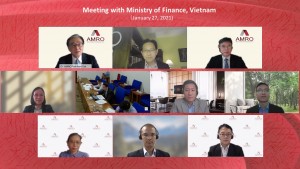
SINGAPORE, February 19, 2021 – Vietnam’s GDP growth is expected to rebound to 7 percent in 2021, riding on a recovery in external demand, a resilient domestic economy, and increased production capacity. Amid heightened uncertainty, continued policy support is essential to bolster the nascent economic recovery and facilitate the transition to the post-pandemic “new normal”. This is according to the preliminary assessment by the ASEAN+3 Macroeconomic Research Office (AMRO) after its virtual Annual Consultation with the Vietnamese authorities in December 2020 and January 2021.
The AMRO team was led by Lead Specialist, Dr. Seung Hyun Luke Hong. AMRO Director, Mr. Toshinori Doi, and Chief Economist, Dr. Hoe Ee Khor, participated in policy meetings. The discussions focused on the impact of the pandemic on the Vietnam economy and policy response in supporting recovery while maintaining stability.
Recent Development and Outlook
“Vietnam’s economic growth slowed to 2.9 percent in 2020 due to the pandemic but is expected to rise to 7 percent in 2021,” said Dr. Hong. “The rebound is expected to be underpinned by a recovery in external demand, a resilient domestic economy, capital inflows, and increased production capacity.”
After a sharp drop in the second quarter, economic growth started to rebound in the third quarter of 2020. The recovery was broad-based. Manufacturing activity was boosted by a robust export sector, which benefited from Vietnam’s relatively resilient export mix, as well as trade diversion from the US-China trade tension. Meanwhile, domestic consumption recovered following the relaxation of mobility restrictions, a result of the authorities’ effective COVID-19 containment efforts. Furthermore, the rebound benefited from an acceleration in the disbursement of public investment.
Risks and Vulnerabilities
A protracted and uneven recovery of the global economy may jeopardize the recovery in external demand. While domestic demand has picked up after a relatively successful containment of the pandemic, it remains susceptible to the risk of further waves of COVID-19 infection. Moreover, scarring effects of the pandemic, such as the impairment of the balance sheets of the business sector, and the hit on unemployment and labor market, may undermine the prospect of recovery.
On the financial front, there is a risk that a deterioration of the banking system’s asset quality will erode its relatively thin capital buffers. Vulnerabilities may also emerge from the sizeable consumer loan segment and from a sharp rise in the holdings of corporate bonds by banks. Heightened risk aversion as well as policy surprises in major economies could lead to renewed turbulence in asset prices and capital outflows. Lastly, the authorities should closely monitor any developments related to the allegation of currency manipulation by the US Department of the Treasury.
Policy Recommendations
Greater fiscal support through both revenue and expenditure measures may be necessary to support the nascent economic recovery if the growth momentum were to weaken, while targeted support to micro, small and medium enterprises and low-income households needs to continue and be regularly reviewed for its relevance and effectiveness. Enhancement of support programs through simpler and better-targeted disbursement will facilitate the effective use of government funds.
Meanwhile, given the benign inflation outlook, it is essential that monetary policy remains supportive of economic recovery, keeping financing costs affordable for households and businesses. With more accommodative financial conditions, heightened supervision of lending to risky sectors remains warranted to mitigate the risk of an asset bubble. In addition, enhanced supervision in this sector is important in order to safeguard the quality of bank credit in the period ahead.
On the external front, with high uncertainties in the post-pandemic global recovery, the authorities’ efforts to strengthen the external buffer should continue and supported with greater flexibility in the exchange rate.
Lastly, it is essential to ensure continued support for long-term development issues, such as infrastructure development, human capital development, social safety net, and particularly public health, while carefully managing risks to long-term fiscal sustainability.
The AMRO team would like to express its gratitude to the Vietnamese authorities and other participating organizations for their cooperation and candid exchange of views. AMRO wishes to express its appreciation for the strong support and coordination from the authorities and the excellent arrangement that has made this virtual mission possible.
 Top row (from L to R): AMRO Director Toshinori Doi, AMRO Chief Economist Hoe Ee Khor, AMRO Lead Economist Seung Hyun (Luke) Hong.
Top row (from L to R): AMRO Director Toshinori Doi, AMRO Chief Economist Hoe Ee Khor, AMRO Lead Economist Seung Hyun (Luke) Hong.
Middle row (from L to R): AMRO Senior Economist Nguyen Thi Kim Cuc, Ministry of Finance of Vietnam Director General Ha Duy Tung and colleagues, AMRO Associate Hoang Viet Phuong, AMRO Associate Nguyen Thang Long.
Bottom row (from L to R): AMRO Economist Marthe Memoracion Hinojales, AMRO Economist Jade Vichyanond, AMRO Senior Specialist Jinho Choi.
 Top row (from L to R): AMRO Director Toshinori Doi, AMRO Chief Economist Hoe Ee Khor, AMRO Lead Economist Seung Hyun (Luke) Hong.
Top row (from L to R): AMRO Director Toshinori Doi, AMRO Chief Economist Hoe Ee Khor, AMRO Lead Economist Seung Hyun (Luke) Hong.
Middle row (from L to R): AMRO Senior Economist Nguyen Thi Kim Cuc, State Bank of Vietnam Director General To Huy Vu and colleague, AMRO Associate Hoang Viet Phuong, AMRO Associate Nguyen Thang Long
Bottom row (from L to R): AMRO Economist Marthe Memoracion Hinojales, AMRO Economist Jade Vichyanond, AMRO Senior Specialist Jinho Choi.
About AMRO
The ASEAN+3 Macroeconomic Research Office (AMRO) is an international organization established to contribute towards securing macroeconomic and financial stability of the ASEAN+3 region, which includes 10 members of the Association of Southeast Asian Nations (ASEAN) and China; Hong Kong, China; Japan; and Korea. AMRO’s mandate is to conduct macroeconomic surveillance, support the implementation of the regional financial arrangement, the Chiang Mai Initiative Multilateralisation (CMIM), and provide technical assistance to the members.
